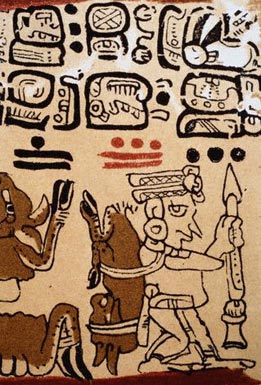In this detail from an almanac contained in the Madrid Codex, a hunter returns home with his kill. Is that a horse on his back?

Since its discovery in 1860, the Madrid Codex, named for the city where it was found after hundreds of years of obscurity and where it rests today, has illuminated many mysteries of ancient Mayan culture, religion, and scholarship. A Spanish priest or explorer likely brought the codex to Spain in the 16th century, though no one knows for sure how it arrived in Europe from Guatemala, where it probably originated.
The longest of the existing Maya hieroglyphic manuscripts, the codex contains over 250 almanacs, which describe events of daily life during the 260-day Mesoamerican ritual calendar. Scholars believe the codex may be a 14th- or 15th-century copy of Mayan scholarship from the peak of the civilization's power. The entire Mayan era lasted from roughly 2500 B.C. to A.D. 1500.
Joel Hardy - 8 Sept. 2003
Return to top
Return to Questions
HOME

